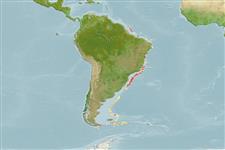Environment: milieu / climate zone / depth range / distribution range
Οικολογία
Θαλασσινό(ά) βαθύβιο(ς); εύρος βάθους 366 - ? m (Ref. 46206). Deep-water
Southwest Atlantic: Brazil.
Μέγεθος / Βάρος / Age
Maturity: Lm ? range ? - ? cm
Max length : 24.2 cm TL αρσενικό/απροσδιόριστο; (Ref. 115012); μεγ. δημοσιευμένο βάρος: 91.50 g (Ref. 115012)
Minimum depth from Ref. 58018.
Life cycle and mating behavior
Γεννητική Ωρίμανση | Αναπαραγωγή | Γεννοβολία | Αβγά | Γονιμότητα | Προνύμφες
Sato, T. and T. Nakabo, 2002. Paraulopidae and Paraulopus, a new family and genus of aulopiform fishes with revised relationships within the order. Ichthyol. Res. 49(1):25-46. (Ref. 41636)
IUCN Red List Status (Ref. 130435: Version 2024-2)
Threat to humans
Harmless
Human uses
Εργαλεία
Special reports
Download XML
Διαδικτυακές πηγές
Estimates based on models
Preferred temperature (Ref.
123201): 5.9 - 10.1, mean 6.9 °C (based on 11 cells).
Phylogenetic diversity index (Ref.
82804): PD
50 = 0.5000 [Uniqueness, from 0.5 = low to 2.0 = high].
Bayesian length-weight: a=0.00347 (0.00182 - 0.00661), b=3.16 (2.99 - 3.33), in cm total length, based on LWR estimates for this species & (Sub)family-body (Ref.
93245).
Τροφικό Επίπεδο (Ref.
69278): 3.6 ±0.5 se; based on size and trophs of closest relatives
Fishing Vulnerability (Ref.
59153): Low vulnerability (14 of 100).
